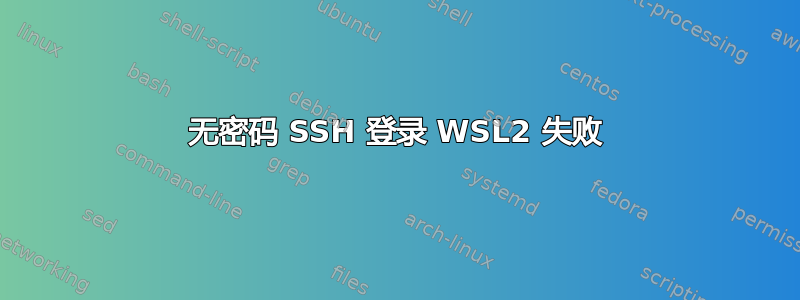
我已遵循 Scott Hanselman 的指示找到这篇博客文章设置 open-ssh 服务器
总之我做了以下事情:
# in WSL2 - install openssh-server
sudo apt install openssh-server
# in WSL2 - check ssh version
ssh -V # -> OpenSSH_8.2p1 Ubuntu-4ubuntu0.4, OpenSSL 1.1.1f 31 Mar 2020
# in WSL2 - generate new host keys
ssh-keygen -t ras -b 4096 -f /etc/ssh/ssh_host_rsa_key
ssh-keygen -t ed25519 -f /etc/ssh/ssh_host_ed25519_key
私钥的权限设置为600,公钥为644
我的sshd_config供你参考
# $OpenBSD: sshd_config,v 1.103 2018/04/09 20:41:22 tj Exp $
# This is the sshd server system-wide configuration file. See
# sshd_config(5) for more information.
# This sshd was compiled with PATH=/usr/bin:/bin:/usr/sbin:/sbin
# The strategy used for options in the default sshd_config shipped with
# OpenSSH is to specify options with their default value where
# possible, but leave them commented. Uncommented options override the
# default value.
Include /etc/ssh/sshd_config.d/*.conf
Port 2222
#AddressFamily any
ListenAddress 0.0.0.0
#ListenAddress ::
#HostKey /etc/ssh/ssh_host_rsa_key
#HostKey /etc/ssh/ssh_host_ecdsa_key
#HostKey /etc/ssh/ssh_host_ed25519_key
# Ciphers and keying
#RekeyLimit default none
# Logging
#SyslogFacility AUTH
#LogLevel INFO
# Authentication:
#LoginGraceTime 2m
#PermitRootLogin prohibit-password
#StrictModes yes
#MaxAuthTries 6
#MaxSessions 10
#PubkeyAuthentication yes
# Expect .ssh/authorized_keys2 to be disregarded by default in future.
# @amin: Removed second one AuthorizedKeysFile .ssh/authorized_keys .ssh/authorized_keys2
AuthorizedKeysFile .ssh/authorized_keys
#AuthorizedPrincipalsFile none
#AuthorizedKeysCommand none
#AuthorizedKeysCommandUser nobody
# For this to work you will also need host keys in /etc/ssh/ssh_known_hosts
#HostbasedAuthentication no
# Change to yes if you don't trust ~/.ssh/known_hosts for
# HostbasedAuthentication
#IgnoreUserKnownHosts no
# Don't read the user's ~/.rhosts and ~/.shosts files
#IgnoreRhosts yes
# To disable tunneled clear text passwords, change to no here!
PasswordAuthentication no
#PermitEmptyPasswords no
# Change to yes to enable challenge-response passwords (beware issues with
# some PAM modules and threads)
ChallengeResponseAuthentication no
# Kerberos options
#KerberosAuthentication no
#KerberosOrLocalPasswd yes
#KerberosTicketCleanup yes
#KerberosGetAFSToken no
# GSSAPI options
#GSSAPIAuthentication no
#GSSAPICleanupCredentials yes
#GSSAPIStrictAcceptorCheck yes
#GSSAPIKeyExchange no
# Set this to 'yes' to enable PAM authentication, account processing,
# and session processing. If this is enabled, PAM authentication will
# be allowed through the ChallengeResponseAuthentication and
# PasswordAuthentication. Depending on your PAM configuration,
# PAM authentication via ChallengeResponseAuthentication may bypass
# the setting of "PermitRootLogin without-password".
# If you just want the PAM account and session checks to run without
# PAM authentication, then enable this but set PasswordAuthentication
# and ChallengeResponseAuthentication to 'no'.
UsePAM yes
#AllowAgentForwarding yes
#AllowTcpForwarding yes
#GatewayPorts no
X11Forwarding yes
#X11DisplayOffset 10
#X11UseLocalhost yes
#PermitTTY yes
PrintMotd no
#PrintLastLog yes
#TCPKeepAlive yes
#PermitUserEnvironment no
#Compression delayed
#ClientAliveInterval 0
#ClientAliveCountMax 3
#UseDNS no
#PidFile /var/run/sshd.pid
#MaxStartups 10:30:100
#PermitTunnel no
#ChrootDirectory none
#VersionAddendum none
# no default banner path
#Banner none
# Allow client to pass locale environment variables
AcceptEnv LANG LC_*
# override default of no subsystems
Subsystem sftp /usr/lib/openssh/sftp-server
# Example of overriding settings on a per-user basis
#Match User anoncvs
# X11Forwarding no
# AllowTcpForwarding no
# PermitTTY no
# ForceCommand cvs server
在 WSL2 上我们没有,systemd所以我用以下方式启动 SSHservice ssh start
现在,如果我打开Powershell并使用 ssh 进入我的 WSL2,ssh -p 2222 myuser@wsl2ip我可以毫无问题地使用我的密码登录。
接下来,我通过运行将我的 Windows 公钥从 Win 复制到 WSL2
type $env:USERPROFILE\.ssh\id_rsa.pub | ssh -p 2222 myUser@wsl2 "cat >> .ssh/authorized_keys"
那里的内容看起来像
ssh-rsa AAAAB3N************O1s= myWinUser@DESKTOP-AE*****
我的 WSL2 中的权限~/.ssh如下
-rw------- 1 575 Jan 17 14:32 authorized_keys
-rw------- 1 97 Aug 30 11:17 config
-r-------- 1 411 Dec 2 2020 id_ed25519
-rw------- 1 100 Dec 2 2020 id_ed25519.pub
-rw------- 1 3389 Jan 17 2021 id_rsa
-rw-r--r-- 1 749 Jan 17 2021 id_rsa.pub
-rw-r--r-- 1 4866 Oct 7 16:19 known_hosts
,并PasswordAuthentication通过no在 WSL2 的sshd_config
每次我尝试使用我的 ssh 密钥登录时都会得到
myuser@wsl2ip: Permission denied (publickey)
RSA如果我使用、RSA4096或ED25519键重复相同的过程,就会发生同样的事情。
是什么赋予了?
答案1
一些想法:
首先,失败的最可能原因是 Ramhound 在评论中提到的密钥权限。您刚刚提到将私钥从 Windows 复制到
~/.ssh/authorized_keys,但没有提到更改权限。尝试:chmod 600 ~/.ssh/authorized_keys希望这会起作用,但如果不起作用,请尝试:
sudo service ssh stop sudo mkdir /run/sshd sudo chmod 0755 /run/sshd sudo /usr/sbin/sshd -d这将
sshd在前台运行并进行额外的调试。希望那将告诉您密钥被拒绝的原因。
在 WSL2 中启用 SSH 的首选方法
您在问题中链接的页面是这样的:
在你阅读后续内容之前,请勿按照本文中的说明进行操作如何从外部机器通过 SSH 进入 Windows 10 上的 Bash 和 WSL2并为您做出了正确的决定!
所以我很好奇为什么您选择较旧的端口转发方法,而不是他提出的将 Windows OpenSSH shell 设置为bash.exe(过时的信息,但仍然有效)命令的替代方法。
无论如何,我(和其他人)认为 Hanselman 的技术还有更好的替代方案。
此方法的优点:
- 无需端口转发
- 由于它依赖于 Windows 服务,因此需要最少的防火墙工作
- 即使安装了多个 WSL 发行版也能正常工作
- 适用于
sshfs、、、scpAnsiblesftp以及任何需要真实 SSH 连接的应用程序或服务。
总结如下:
- 我们依靠 WSL2 将 Windows 上的“localhost”连接转发到 WSL(又名 localhost 转发)的能力。
- 我们使用 Windows OpenSSH 服务器作为 WSL2 OpenSSH 服务器的 JumpHost。
初始设置与 Hanselman 的“简单方法”相同。首先启用 Windows OpenSSH 服务器在端口 22 上。
(特别是对于未来的读者)我建议只需遵循 Microsoft 文档即可获得最新信息,但我也会在此处复制相关命令。从 PowerShell:
# Sounds like you had the Client already installed, at least Add-WindowsCapability -Online -Name OpenSSH.Client~~~~0.0.1.0 Add-WindowsCapability -Online -Name OpenSSH.Server~~~~0.0.1.0 Start-Service sshd Set-Service -Name sshd -StartupType 'Automatic' # Confirm the Firewall rule is configured. It should be created automatically by setup. Run the following to verify if (!(Get-NetFirewallRule -Name "OpenSSH-Server-In-TCP" -ErrorAction SilentlyContinue | Select-Object Name, Enabled)) { Write-Output "Firewall Rule 'OpenSSH-Server-In-TCP' does not exist, creating it..." New-NetFirewallRule -Name 'OpenSSH-Server-In-TCP' -DisplayName 'OpenSSH Server (sshd)' -Enabled True -Direction Inbound -Protocol TCP -Action Allow -LocalPort 22 } else { Write-Output "Firewall rule 'OpenSSH-Server-In-TCP' has been created and exists." }如果您是 Windows 安装的管理员,建议--编辑
C:\Program Data\ssh\sshd_config并注释掉以下几行:#Match Group administrators # AuthorizedKeysFile __PROGRAMDATA__/ssh/administrators_authorized_keys当您编辑该内容时,我假设您需要设置:
PasswordAuthentication no默认情况下,Windows OpenSSH 会查找
C:\Program Data\ssh\administrators_authorized_keys(参见这个问题)。通过注释掉这些行,您将改用您的%userprofile%\.ssh\authorized_keys。将您的公钥添加到
%userprofile%\.ssh\authorized_keys。确保权限严格这个答案(或相关答案)。确认您可以使用密钥从 WSL 登录到 Windows OpenSSH:
ssh -i <path_to_private_key> "${HOSTNAME}.local"
到现在为止,你确实终端已经可以通过 Windows OpenSSH 访问 WSL2。
从网络上的任意一台机器:
ssh -t <windows_host_or_ip> wsl
这将wsl在连接到 Windows 后简单地运行命令。
这适用于 shell 访问,但如果您需要对 WSL 进行“真正的” ssh 访问以用于 Andible、sshfs、sftp、scp 等,请继续阅读...
接下来(对于其他阅读本文的人来说)在 WSL 中配置 OpenSSH。您已经完成了这一部分。端口2222是一个不错的选择。
将您的公钥复制到~/.ssh/authorized_keys(已为您完成)并确保您的权限正确(如上所述)。
如果还没有,请ssh-agent通过以下方式添加您的私钥:
eval $(ssh-agent) # under Linux
ssh-add <path_to_key
(注意:Windows 也支持ssh-add。只需确保“OpenSSH 身份验证服务”正在运行)。
此时,您可以使用 Windows 主机作为您的 JumpHost,如下所示:
ssh -J <windows_host_or_ip> -p 2222 localhost
这连接到视窗OpenSSH 服务器(在端口 22 上)然后转身并连接到localhost:2222,即您的 WSL2 实例。
如上所述,这现在适用于scp、sshfs等。
可选:
此技术有一个“副作用”,即localhost无论您使用哪个端口或跳转主机进行连接,它都会被存储为相同的“已知主机”。因此,如果您以这种方式连接到多个 WSL 实例,ssh就会开始抱怨潜在的中间人问题。
避免这种情况(并且总体上简化事情)的最佳方法是Host在 中创建一个条目~/.ssh/config。假设您的 Windows 主机名是bubblegum,而您的 WSL 发行版是ubuntu。将以下内容添加到~/.ssh/config:
Host bubblegum_ubuntu # Can be whatever you want
Hostname localhost
User <username> # If needed
Port 2222
ProxyJump bubblegum
UserKnownHostsFile ~/.ssh/known_hosts_bubblegum_ubuntu
这会将known_host条目重定向到一个文件仅有的用于该特定主机。
这也意味着您现在可以:
ssh bubblegum_ubuntu
scp bubblegum_ubuntu:/home/username/filename .
sftp bubblegum_ubuntu
sshfs bubblegum_ubuntu:/ /mountpoint


